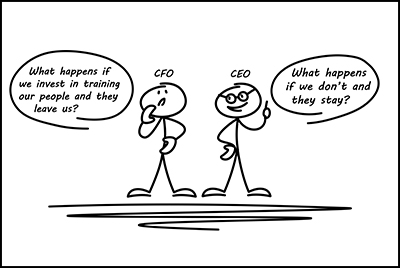By Alan D. Sobel, CPA, CGMA, SobelCo
“As a leader, you set the tone for your entire team. Communicate your vision.”
—General Colin Powell
Much has been written about “tone at the top.” A great tone brings everyone to a higher level of performance. But the wrong tone may be the first way that success is derailed, especially if that tone doesn’t support the strategic objectives of your organization. In the worst case, the wrong tone could result in colleagues working against the company’s goals. Why would anyone be motivated to ensure an objective is achieved if leadership of an organization doesn’t set the right tone?

The Importance of People
Throughout my professional career, I have strongly believed that the most important responsibility of any leader is the professional development of the people they lead. It is more important than the organization’s growth. It is more important than delivering excellent client service. It is more important than processes, technology and policies. It is even more important than your own professional development … although one could argue that it’s a leader’s personal development that results in the effective development of others.
Leveraging the development of others is the catalyst that allows other key drivers in business to be successful. Regardless of length of service or experience or level of expertise, the development and nurturing of people in any organization is the key to success. Very few company leaders can succeed on their own. Most rely on a motivated, highly skilled team to achieve the company’s tactical and strategic goals. It is the people in an organization that create the capabilities that allow for growth. The bottom line is that no matter how fast a business wants to grow, it is limited without highly competent employees.
Setting Priorities
Unfortunately, fostering the professional development of others is not a top priority for some leaders. This is not usually from a lack of understanding its importance, but rather because it takes a lot of time, effort and commitment. It’s not as simple as just sending people to a CPE program or watching a webinar, although those can be effective tools to help professionals develop.
Let’s face it, when a client or customer calls, we drop everything to address their needs. When a deadline is approaching, and we all know there are daily deadlines, we will work overtime to meet those deadlines. But too often the time devoted to coaching our most valuable assets are neglected, or put on hold until the next day, or the next or the next.
Another concern is often the cost associated with developing our people. The CEO’s response in the image above is a perfect example of setting the right tone at the top when it comes to cultivating people. Setting the tone starts by recognizing that investing in people is not a cost, but a way to add value to our service delivery models.
Although it is important to be a cheerleader and advocate, leading by example sets the tone by doing the things that you are asking others to do. Great leaders work with their teams to encourage professional development and affirm it as a priority. Leaders can demonstrate that they care about their people by constantly reinforcing the business case of how developing others adds incremental value to an organization.

But as the CFO points out in the image above, our efforts and investment in our staff don’t always pay off. We can do everything right, and still people leave organizations. Setting the tone means that you keep moving forward, making changes and preparing the business to keep improving. Leaders must always play to the highest common denominator and avoid accepting an “it’s not worth it” mentality. Organizations cannot afford to have leaders with a negative attitude or who project that nurturing the team can lead to wasted efforts.
Instead, keep an open mind, set the right tone and provide the tools to help everyone be their best. Who knows, your young associate may grow into the next great executive—or may even be your successor!
Reprinted with permission of the New Jersey Society of CPAs.